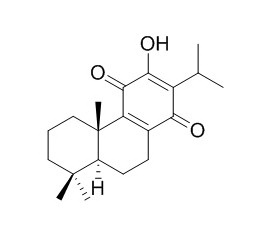Royleanone
Royleanone possesses cytotoxic activity against the human pancreatic cancer cell line MIA PaCa-2.
Inquire / Order:
manager@chemfaces.com
Technical Inquiries:
service@chemfaces.com
Tel:
+86-27-84237783
Fax:
+86-27-84254680
Address:
1 Building, No. 83, CheCheng Rd., Wuhan Economic and Technological Development Zone, Wuhan, Hubei 430056, PRC
Providing storage is as stated on the product vial and the vial is kept tightly sealed, the product can be stored for up to
24 months(2-8C).
Wherever possible, you should prepare and use solutions on the same day. However, if you need to make up stock solutions in advance, we recommend that you store the solution as aliquots in tightly sealed vials at -20C. Generally, these will be useable for up to two weeks. Before use, and prior to opening the vial we recommend that you allow your product to equilibrate to room temperature for at least 1 hour.
Need more advice on solubility, usage and handling? Please email to: service@chemfaces.com
The packaging of the product may have turned upside down during transportation, resulting in the natural compounds adhering to the neck or cap of the vial. take the vial out of its packaging and gently shake to let the compounds fall to the bottom of the vial. for liquid products, centrifuge at 200-500 RPM to gather the liquid at the bottom of the vial. try to avoid loss or contamination during handling.
Ecol Evol.2022, 12(11):e9459.
Biomolecules.2023, 13(2):227.
Mol Cells.2015, 38(9):765-72
iScience.2023, 26(9):107602.
Front Immunol.2024, 15:1423776.
J Ethnopharmacol.2024, 320:117426.
Appl. Sci. 2021, 11(10),4666.
Sci Rep.2019, 9:12132
Regul Toxicol Pharmacol.2024, 149:105620.
Plant Cell Physiol.2023, 64(7):716-728.
Related and Featured Products
Phytochem Anal. 2009 Jul-Aug;20(4):320-7.
Antioxidant diterpenoids from the roots of Salvia barrelieri.[Pubmed:
19402189 ]
The phytochemical and biological studies carried out on Salvia species showed that their extracts and constituents have various biological activities.
The aim of this study was the isolation of diterpenoids from the roots of Salvia barrelieri Ettling and the determination of the antioxidant activity.
METHODS AND RESULTS:
Chromatographic methods were used for fractionation and isolation, respectively. Structure elucidation was established by spectroscopic methods. Five antioxidant assays were performed.
Three new abietane diterpenoids barreliol, Royleanone 12-methyl ether and 7-epi-salviviridinol, and six known diterpenoids, with a known dammarane triterpenoid, pyxinol were isolated. The absolute stereochemistry of pyxinol was confirmed by X-ray analysis.
CONCLUSIONS:
Taxodione exhibited the highest antioxidant activity among the tested compounds.
Nat Prod Commun. 2011 May;6(5):575-9.
Bioactivity-guided study of antiproliferative activities of Salvia extracts.[Pubmed:
21615011]
The cytotoxic activities of the n-hexane, chloroform and aqueous methanolic fractions prepared from the methanolic extract of the leaves of 23 Salvia taxa were studied for their cell growth-inhibitory activity against human cervix adenocarcinoma (HeLa), skin carcinoma (A431) and breast adenocarcinoma (MCF7) cells using the MTT assay.
METHODS AND RESULTS:
The n-hexane fractions of six Salvia taxa (S. hispanica, S. nemorosa, S. nemorosa 1. albiflora, S. pratensis, S. recognita and S. ringens) and the chloroform fraction ofS. officinalis 1. albiflora produced over 50% growth inhibition of the skin carcinoma cell line. None of the tested extracts showed substantial (above 50%) antiproliferative effects against HeLa and MCF7 cells. S. ringens was the most powerful among the studied Salvia species with a 61.8% cell growth inhibitory activity on A431 cells. In the case of S. ringens, other plant parts were also tested for antiproliferative effect, and the highest activities were recorded for the root extract. This was subjected to bioactivity-guided fractionation, which yielded four abietane diterpenes (Royleanone, horminone, 7-O-methyl-horminone and 7-acetyl-horminone), one triterpene (erythrodiol-3-acetate) and beta-sitosterol.
CONCLUSIONS:
Horminone, 7-acetyl-horminone and erythrodiol-3-acetate displayed marked concentration-dependent antiproliferative effects, while Royleanone and 7-O-methyl-horminone produced weaker activities.
Phytochemistry. 2012 Jun;78:107-19.
Abietane diterpenes induce cytotoxic effects in human pancreatic cancer cell line MIA PaCa-2 through different modes of action.[Pubmed:
22436445 ]
Abietane diterpenes, especially those containing quinone moieties, are often reported to have cytotoxic effects on cancer cell lines. They deserve greater attention because several cancer chemotherapeutic agents also possess the quinone structural feature. To date, very little is known about their cytotoxic molecular modes of action.
METHODS AND RESULTS:
In the present study, five diterpenes, 7 alpha-acetoxyRoyleanone, horminone, Royleanone, 7-ketoRoyleanone and sugiol which have been previously isolated from the medicinal plant Peltodon longipes were shown to possess cytotoxic activity against the human pancreatic cancer cell line MIA PaCa-2.
CONCLUSIONS:
7 alpha-AcetoxyRoyleanone, horminone and Royleanone were demonstrated to possess alkylating properties using the nucleophile 4-(4-nitrobenzyl)pyridine. However, no clear correlation between the alkylating properties and cytotoxicity of these diterpenes was observed.



